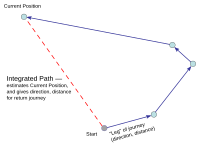
Photo from wikipedia
Spatial integration during the brain's cognitive activity prompts changes in energy used by different neuroglial populations. Nevertheless, the organisation of such integration in 3D ‐brain activity remains undescribed from a… Click to show full abstract
Spatial integration during the brain's cognitive activity prompts changes in energy used by different neuroglial populations. Nevertheless, the organisation of such integration in 3D ‐brain activity remains undescribed from a quantitative standpoint. In response, we applied a cross‐correlation between brain activity and integrative models, which yielded a deeper understanding of information integration in functional brain mapping. We analysed four datasets obtained via fundamentally different neuroimaging techniques (functional magnetic resonance imaging [fMRI] and positron emission tomography [PET]) and found that models of spatial integration with an increasing input to each step of integration were significantly more correlated with brain activity than models with a constant input to each step of integration. In addition, marking the voxels with the maximal correlation, we found exceptionally high intersubject consistency with the initial brain activity at the peaks. Our method demonstrated for the first time that the network of peaks of brain activity is organised strictly according to the models of spatial integration independent of neuroimaging techniques. The highest correlation with models integrating an increasing at each step input suggests that brain activity reflects a network of integrative processes where the results of integration in some neuroglial populations serve as an input to other neuroglial populations.
Journal Title: European Journal of Neuroscience
Year Published: 2021
Link to full text (if available)
Share on Social Media: Sign Up to like & get
recommendations!